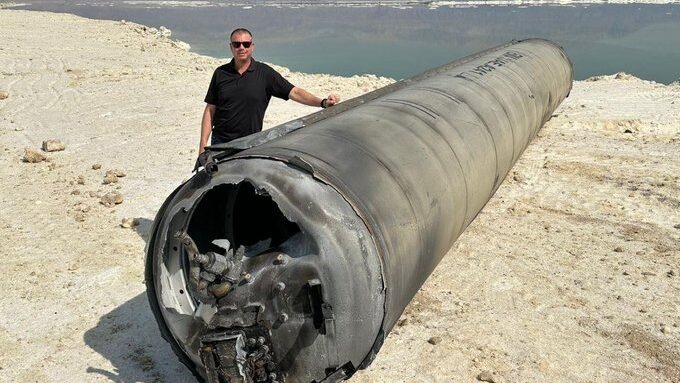Iran Unleashes Sophisticated Missiles; Israel Counters with Cutting-Edge Defense
Iran launched a major attack on Israel with over 300 threats, including UAVs, cruise missiles, and ballistic missiles. Israeli technology and coalition intercepted 99% of them, with only minor damage reported
On Saturday evening, Iran initiated an unprecedented attack against Israel, launching over 300 aerial threats of various types. Including approximately 170 unmanned aerial vehicles (UAVs), more than 30 cruise missiles, and 120 ballistic missiles. Israel reported a 99% success rate in the interception of threats.
“The Iranian threat met the aerial and technological superiority of the IDF, along with a strong fighting coalition—which together intercepted the overwhelming majority of the threats,” said IDF spokesperson Daniel Hagari in a statement on Sunday, calling the event “a very significant strategic achievement.”
Uzi Rubin, former director of the Israeli Defense Ministry’s Missile Defense Organization, told The Media Line that while the Iranian threat is “real and deadly,” Israel is equipped to confront it. “They have very capable missiles, but we have very capable defense,” he added.
The IDF said only a few threats crossed into Israeli territory, with the rest being intercepted.
“These fell at the Nevatim Air Force Base, causing only minor damage to infrastructure. As you can see, the base is operational and continues to carry out its missions,” the statement added.
One injury was reported as a result of the attack. A 7-year-old girl from a Bedouin village close to Arad, an Israeli Southern city, is reported to be seriously injured by shrapnel caused by one of the interceptions of the missiles.
What are the threats launched at Israel?
Among the over 300 threats launched on Saturday by Iran toward Israel are UAVs, cruise missiles, and ballistic missiles. Dr. Eyal Pinko, a former senior intelligence officer and professor at Bar-Ilan University, an expert in intelligence and cyber, and the former head of the Israeli Navy Interceptor’s development programs, unpacked the details during an interview with The Media Line.
The over 170 UAVs launched by Iran are called Shahid 139. This is a UAV mass-manufactured in Iran, and Russia is also using it against Ukraine, Pinko explained. “The Russians bought 9000 pieces of them to hit Ukraine, and most of the Russian attacks in Ukraine are with this UAV,” he added.
Give the gift of hope
We practice what we preach:
accurate, fearless journalism. But we can't do it alone.
- On the ground in Gaza, Syria, Israel, Egypt, Pakistan, and more
- Our program trained more than 100 journalists
- Calling out fake news and reporting real facts
- On the ground in Gaza, Syria, Israel, Egypt, Pakistan, and more
- Our program trained more than 100 journalists
- Calling out fake news and reporting real facts
Join us.
Support The Media Line. Save democracy.


Pinko noted that this UAV is based on an Israeli UAV called “Harpy,” and Iran used reverse engineering to create it. “It goes very slowly,” said Pinko, adding that its speed is about 180km per hour. He noted that its range is 2700km, and it can carry about 40 kilos of explosives.
He notes that these UAVs are also known as suicide or Kamikaze drones, as their purpose is to crash and explode. “They determine the trajectory and the flight path, and according to the GPS, it just goes on to the place and crashes over,” he said.
Regarding the cruise missiles, of which some 30 were fired, Pinko says that it is very likely that the Abu Mahdi, also known as the Soumar missile, was the one used. “This is an Iranian-made cruise missile based on reverse engineering of Russian cruise missiles: KH 55,” he continued.
Pinko explained that it has a range of 2,500 kilometers, can carry some 200 kilos of explosives, and speeds about 800 km per hour. It also uses GPS navigation and image correlation technology to reach its target.
“Before launching the missile, they upload a picture of the target. The missile navigates to the area using GPS. Once it reaches the area, it has a seeker feature, which is basically a camera. It takes a picture of the target and does some kind of correlation between the target and the picture, and it dives into this target,” Pinko said.
According to the ranges of the over 120 ballistic missiles that Iran possesses in its arsenal, Pinko believes that either Sejjil or Emad types were launched. “These missiles go very fast, seven times the speed of sound,” he said.
Pinko adds that the difference between cruise and ballistic missiles is that while the cruise missile goes in a straight path, the ballistic missile leaves the atmosphere and then goes back inside. Ballistic missiles, he explained, come from above at an 80-degree angle.
Rubin noted that these ballistic missiles were used by Iran before against the United States after Kasem Soulemani’s assassination in 2020. In addition to that, he noted that the Houthis have used both the ballistic and the cruise missiles, which were provided by Iran, since October against Israel.
How did Israel defend itself from the attack?
Speaking about the high rate of success of the air defense technologies employed by Israel and its partners, Hagari said on Sunday morning that of approximately 170 UAVs, zero crossed into Israeli territory. “Dozens of them were intercepted by Israeli Air Force fighter jets, our Aerial Defense Array, and the aerial defense systems and aircraft of our partners.”
Of the more than 30 cruise missiles, none crossed into Israeli territory either, he added, noting that 25 of them were intercepted by IAF fighter jets outside the country’s borders.
And out of over 120 ballistic missiles, only a few crossed into Israeli territory, with the rest being intercepted, Hagari said, noting that the ones that fell reached the Nevatim Air Force Base, causing only minor damage to infrastructure.
Pinko says that for the UAVs and the cruise missile threats, Israel used the David Sling, adding that many were also intercepted by aircraft.
“The pilots got the coordinates of the target and fired air-to-air missiles,” he said, adding that this was done by Israeli aircraft and its partners in defense, which included the participation of the British, American, and Jordanian air forces.
Rubin says that the Iron Dome was also employed for these threats, adding that the ballistic missiles were intercepted by the Arrow, an Israeli air defense ground system designed for this kind of threat.
Pinko reiterated that this event showed the Israeli intelligence and air defense systems’ effectiveness. “The intelligence and the defense layers worked properly and even did an excellent job,” he said.

